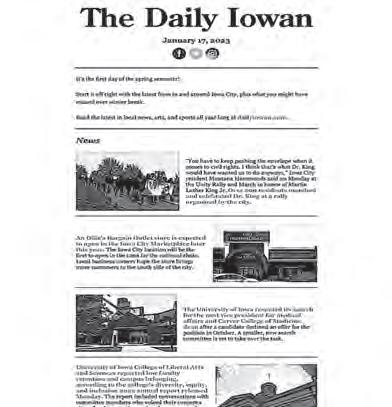
1 minute read
Celebrating Juneteenth in downtown IC
The celebration included a Johnson County resource fair, free food, and fashion show. The event closed with live music from Black queer singer and dancer Isaac Jordan, and Chicago Funk-Rock band Aniba & the Sol Starz.

Advertisement


Continued from 4 and higher,” Kelsay said. “You’ve got water that is rising and rising and rising and never stopping and it’s overtaking homes, it’s overtaking businesses, it’s overtaking roads.”
Kelsay, just like Weber, also witnessed the 1993 floods in Iowa City. Comparing the two, Kelsay said the biggest difference was that much more information was available in 2008 which allowed for a better response.

Kelsay explained that several meetings involving communities in Johnson County were held to plan the response. They needed to address how to best alert the public to the severity of the floods, including the dispersal of information about the how high the water was and where it would be flowing, as well as the safest routes in and out of town.
In his role as a police officer, his work revolved around keeping neighborhoods secure and people safe. This included manning boats that would go out to assist people who had attempted to return to their homes to retrieve belongings or return home permanently.
“When the water started to recede and people could then get to their businesses or their their homes, it almost became more of an issue for us,” Kelsay said. “Because now you no longer have the water as a barrier, people can access or think they can hop in a canoe or wade through the muck to get to their structures, but their structures aren’t safe.”
It wasn’t until inspections were done that confirmed that houses were safe that people could return home, although Kelsay said some areas had been affected enough that buildings would instead be torn down and turned into green areas.
As for the how the flood informed him and the police moving forward, Kelsay said there were lessons learned from the flood that affected the response to the COVID-19 pandemic. Specifically, the data-driven aspect of the flood response was a major part of the pandemic response a decade later.
Aspects like calculating and forecasting water levels turned into calculating in- fection rates by looking at the number of COVID-positive people ending up in hospitals.
“We were able to apply basically the same incident management system that we used for the floods to what we did for COVID, just the threat was the virus instead of rising water, and the resources we needed were masks, technology that we [could use] to get out messages to coordinate people, sanitizing equipment, respirators, hotel rooms, hospital rooms” he said. “Our resources and our needs were different, but the system was exactly the same.” parker-jones@uiowa.edu alejandro-rojas@uiowa.edu








